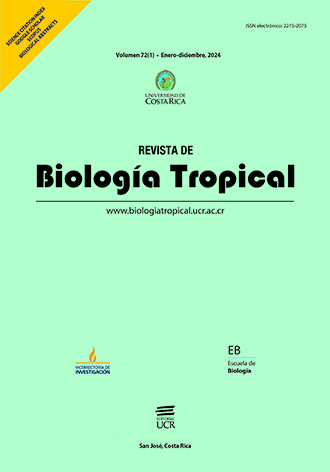Abstract
Introduction: A recent revision of the generic classification of the Trochilidae based on DNA sequences revealed many inconsistencies with the current generic classification, largely based on plumage characters subject to homoplasy, especially in the Trochilini, the largest tribe. A thorough generic reorganization brought the classification into accord with the phylogeny, but due to lack of genetic data, two species remained unclassified. One of these was the Mangrove Hummingbird, “Amazilia” boucardi, endemic to Costa Rica and included in the IUCN red list of threatened species. Objective: To obtain molecular evidence to clarify the generic relationships of “A.” boucardi. Methods: We isolated DNA from tissues of this species and amplified 4 nuclear and 4 mitochondrial fragments and compared these with homologous fragments from 56 species in the Trochilini, constructing phylogenetic trees with maximum likelihood and Bayesian methods. Results: Our phylogenetic analyses confirmed the placement of boucardi in the Trochilini and definitely excluded it from Amazilia but placed it with high confidence in the genus Chrysuronia Bonaparte, 1850, within which its closest relative is C. coeruleogularis, which also inhabits mangroves. Conclusions: Our genetic data based on nuclear and mitochondrial regions clearly indicate the relationship of A. boucardi and L. coeruleogularis. Moreover, it is also support by their habitat distribution in the mangroves of the Pacific coast of Costa Rica and Western Panama. Therefore, we suggested to exclude A. boucardi as "incertae sedis".
References
Bonaparte, C. L. (1850). Conspectus Genera Avium (Vol. 1). Lugduni Batavorum.
Cory, C. B. (1918). Catalogue of birds of the Americas. Field Museum of Natural History publications. Zoological Series.
deLattre, A., & Bourcier, J. (1846). Descripcion de quinque espéces Nouvelles, faisant partie des collections rapportées. Revue Zoologique, 1846, 13–20.
Doyle, J., & Doyle, J. (1990). Isolation of plant DNA from fresh tissue. Focus, 12(1), 13–15.
Gould, J. (1851). On some new species of the Trochilidae. Proceedings of the Zoological Society of London, 19(1), 115–116.
Kearse, M., Moir, R., Wilson, A., Stones-Havas, S., Cheung, M., Sturrock, S., Buxton, S., Cooper, A., Markowitz, S, Duran, C., Thierer, T., Ashton, B., Meintjes, P., & Drummond, A. (2012). Geneious basic: An integrated and extendable desktop software for the organization and analysis of sequence data. Bioinformatics, 28(12), 1647–1649.
Lawrence, G. N. (1867). Descriptions of five new species of birds of Central American birds. Proceedings of the Academy of Natural Sciences of Philadelphia, 19(1867), 232–234.
Lesson, R. P. (1843). L’echo du monde savant. Journal Analytique des Nouvelles et des Cours Scientifiques, 7(32), 756–757.
McGuire, J. A., Witt, Ch. C., Altshuler, D. L., & Remsen, J. V. (2007). Phylogenetic systematic and biogeography of hummingbirds: Bayesian and maximum likelihood of partitioned data and selection of an appropriate partitioning strategy. Systematic Biology, 56(5), 837–856.
McGuire, J. A., Witt, Ch. C., Remsen, J. V., Corl, A., Rabosky, D. L., Altshuler, D. L., & Dudley, R. (2014). Molecular phylogenetics and the diversification of hummingbirds. Current Biology, 24(8), 910–916.
Mulsant, E. M., & Verreaux, E. (1877). Histoire naturelle des oiseaux-mouches ou colibris, constituant la familie des Trochilidées (Vol. 4). Bureau de la Socité Linnéene.
Peters, J. L. (1945). A checklist of the birds of the world (Vol. 5). Harvard University Press.
Rambault, A. (2018). FigTree: tree figure drawing tool (Version 1.4.4). http://tree.bio.ed.ac. uk/software/figtree.
Ridgway, R. (1911). The birds of North and middle America. Bulletin of the American Museum of Natural History.
Reichenbach, G. L. (1855). Trochilidiarum Enumeratio. Cabanisti Diario Ornithologico, 2(1855), 1–12.
Ronquist, F., Teslenko, M., van der Mark, P., Ayres, D. L., Daring, A., Hoehna, S., Larget, B., Liu, L., Suchard, M. A., & Huelsenbeck, J. P. (2011). Mr.Bayes 3.2: efficient Bayesian phylogenetic inference and model choice across a large model space. Systematic Biology, 61(3), 539–542.
Schuchmann, K. L. (1999). Family Trochilidae (Hummingbirds). In J. del Hoyo, A. Elliot, & J. Sargatal (Eds.), Handbook of birds of the world (pp. 468–630). Lynx Editions.
Stamatakis, A. (2014). RAxML version 8: a tool for phylogenetic analysis and post-analysis of large phylogenies. Bioninformatics, 30(9), 1312–1313.
Stiles, F. G., Piacentini, V. De Q., & Remsen, J. V. (2017a). A brief history of the generic classification of the Trochilini (Aves: Trochilidae): The chaos of the past and problems to be resolved. Zootaxa, 4269(3), 396–412.
Stiles, F. G., Remsen, J. V., & McGuire, J. A. (2017b). The generic classification of the Trochilini (Aves: Trochilidae): Reconciling taxonomy with phylogeny. Zootaxa, 4353(3), 401–424.
Stiles, F. G., & Skutch, A. F. (1989). A guide to the birds of Costa Rica. Cornell University Press.
IUCN (Unión Internacional para la Conservación de la Naturaleza). (december 1 2021). The IUCN red list of threatened species. https://www.iucnredlist.org.
##plugins.facebook.comentarios##

This work is licensed under a Creative Commons Attribution 4.0 International License.
Copyright (c) 2024 Revista de Biología Tropical







